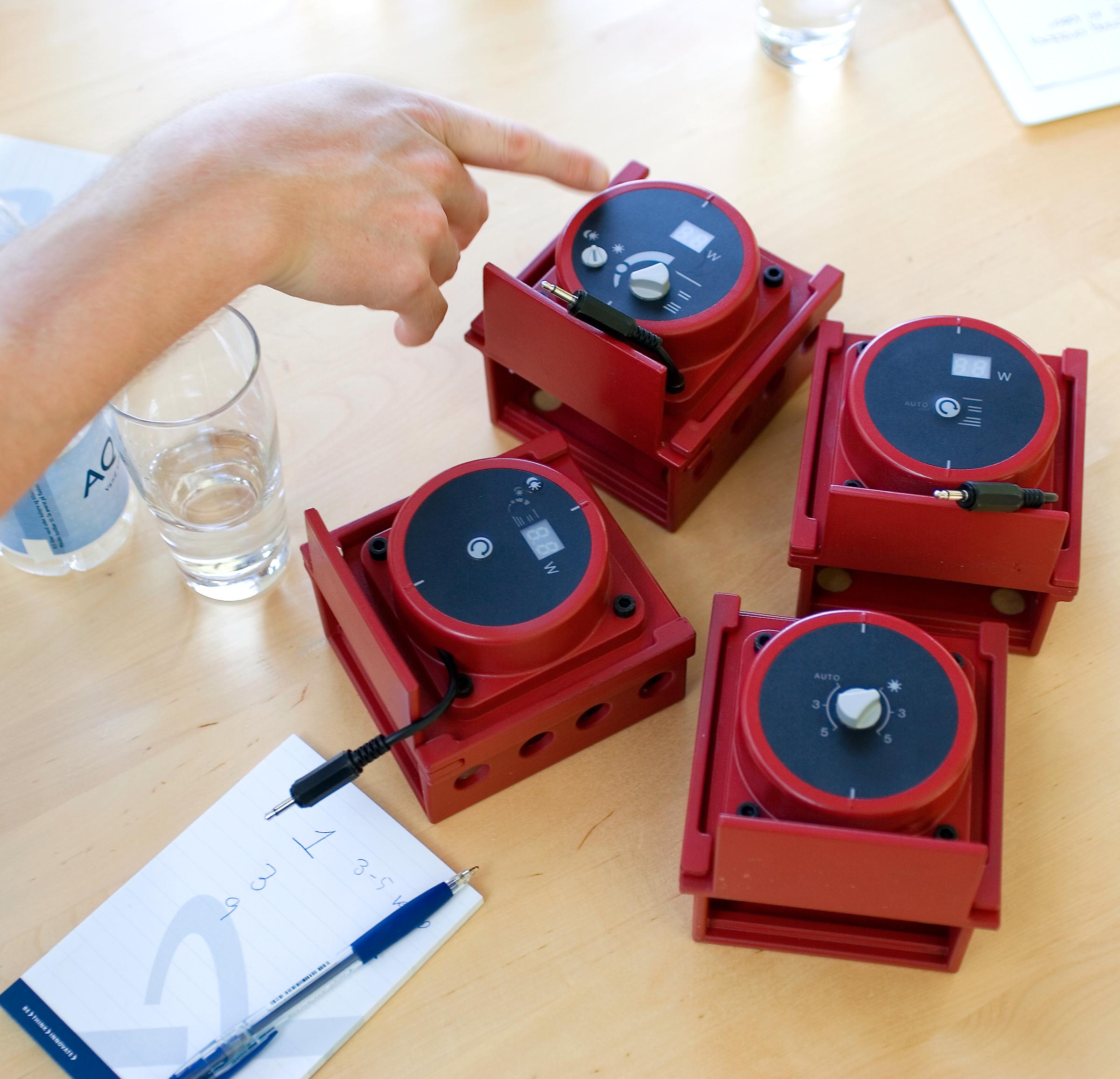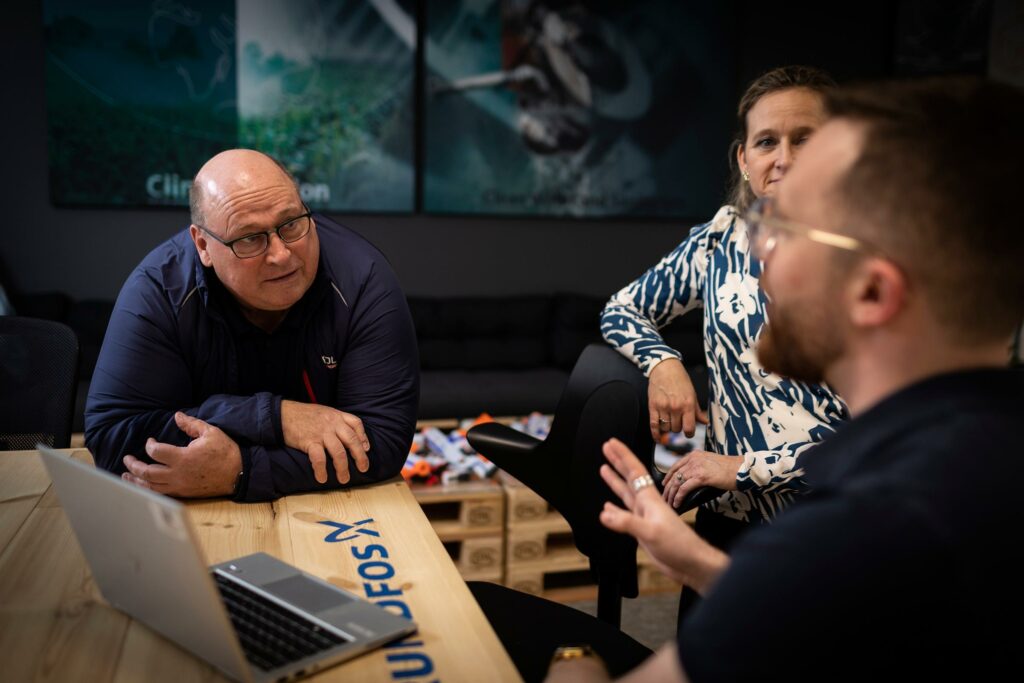How do you discuss sustainability in the earliest design phases when you have hardly any data to go by? This is an important question, as 80 percent of the environmental impact of products stems from the very early design phases. In a MADE research project with Grundfos and DTU, PhD Giácomo Parolin is working to find the answer.

The Grundfos innovation team is gathered around a blue digital model. The digital mesh-structure represents a new pump– and hopefully a sustainable one.
Achieving that sustainability, however, involves all kinds of unknowns: should we try a novel, more sustainable material or maybe a new, more sustainable manufacturing technology? But how would such new ideas play out in real life? And would they even be more sustainable?
“The earlier we are in the design phase the fussier it is because we don’t have much data,” says Lead Sustainable Materials Specialist at Grundfos Jacob Arnbjerg.
The earlier the better
However, it is in the early phases that you can make the biggest difference. Around 80 percent of all the environmental impacts of new products stem from the very earliest design stages.
But as stated – the earlier the design phase, the more the options, and the more “fussiness”.
“When you design a pump, you may have a choice of five different materials and five different production technologies – but you simply don’t have all the data to know what will be the most sustainable,” Arnbjerg explains.
Even though data can be produced by experimenting with the different options, experiments are time consuming and costly, so you can only do a limited amount. Addressing the dilemmas early on helps to narrow it down the most relevant experiments.
To that end, Grundfos has teamed up with Technical University of Denmark – DTU in a MADE FAST research project to find the answer to how to do this.
MADE FAST research project
Name: Defining sustainability goals and managing trade-offs in product development
Partners: Grundfos, DTU
Timespan: 2020-2024
Goal: To develop methods and tools in order to help industrial companies in the early development phase to ensure the most competitive products and solutions when it comes to balanced sustainability.
The project is part of MADE’s research platform MADE FAST, which is an industry-led research, innovation, and education partnership developing the next generation of Danish advanced manufacturing capabilities.
As part of the project, Ph.D. Giácomo Parolin works on creating tools that help making the sustainability dilemmas more tangible in the early design stages.
Watch a presentation of Parolin and his PhD project in the video below. The video is part of the MADE Researchers’ Baton, where investigators in MADE present their research and pass on the baton between them, each time posing a question for the next researcher.
Trade-offs
There are trade-offs to be made in every design option.
“Should they go for a pump that has recycled material in it but has a little bit higher energy consumption, or a pump that doesn’t have any recycled materials – so virgin material – but has better energy efficiency?” Parolin asks.
Another example might be in the choice of production technology. Using a technology such as additive manufacturing (3D-printing) may result in pumps that require less material and potentially are less energy consuming in use but, on the flipside, producing them with an AM – technology might be more energy intensive and non-scalable.
Embracing the complexity
“The key challenge is to embrace the complexity. It’s very easy to say we don’t have enough data to know,” Arnbjerg says.
This challenge is exactly what Parolin is working on. In his PhD project, he is creating two tools that can make the trade-offs transparent and easier to discuss during the early innovation phases.
“One [ed. tool] focuses on how to measure sustainability from a very early innovation stage in technology development. And the second focusses on how to then use that information to make better decisions and solve some dilemmas – some tradeoffs in the design,” Parolin explains.
Four main challenges
By interviewing Grundfos employees as well as taking part in the innovation of a new platform at Grundfos, Parolin has gained insights into the biggest conundrums when addressing sustainability.
So far, he has narrowed it down to four main challenges:
- Data Availability
- Breadth of Scope
- Context Uncertainty
- Need for Clarity.
We have already explored the first challenge: lack of data in the early design phases. The second concerns the complexity of having to discuss sustainability in an innovation process involving different parameters such as materials, how the innovation will be used, production methods and more besides.
Parolin will be addressing these two challenges with his first tool, which currently takes the form of a scorecard where each parameter’s sustainability is assessed using a score from 1-5.
The third, “Context Uncertainty”, is addressed using future scenarios – which we will be covering in the next section.
Lastly, there is the fourth challenge of “Need for Clarity”, which refers to how the concept of “sustainability” can be understood very differently depending on who you ask. Some think of CO2, others water or biodiversity. Parolin currently believes that one solution might be to look at the focus in the sustainability strategy of the company to provide the innovation team with a common language.
However, only one year into his PhD, he is far from finished addressing the four challenges.

Thinking about the future
Circling back to “Context Uncertainty” explored by means of future scenarios, Parolin did an experiment. He introduced some Grundfos teams to future scenarios and compared those teams with teams that had the same task but were not provided with future scenarios. The outcome showed that the future scenarios result in better sustainability discussions and solutions.
“We have to think of future scenarios. So how will society change in ten years? That really impacts how technology might look like from the sustainability point of view,” Parolin says.
One example of this would be if we learned to store green electricity, and all electricity in our homes became green.
“Today, if you had two options, you would always choose the one with the lowest energy consumption. But if all electricity was green this would not be the most important factor – then you might choose the one using less materials instead – or less toxic chemicals,” Parolin explains.
Two years to go
Parolin has two years of his MADE PhD ahead of him for developing his tools and testing them at Grundfos as well as other companies.
“With these two tools – I really hope that not only Grundfos but also companies in MADE and maybe elsewhere get better at making sustainable related decisions,” Parolin says.
Grundfos sees a lot of value in such tools – not just for themselves but for the whole industry.
These tools are tremendously important, as we all draw upon the same resources
Jacob Arnsbjerg, Sustainable Materials Specialist at Grundfos
“These tools are tremendously important, as we all draw upon the same resources,” says Arnbjerg and adds:
“It’s also a matter of transparency. It creates a common language that makes the sustainability of products and the technologies more transparent, as it allows us to talk about the trade-offs.”
According to Arnbjerg, the tools not only have the potential of resulting in more sustainable choices in the early innovation phases, they also have the potential to create a needed mental shift:
“As engineers, we often have a tendency to only trust what can be entered in a spreadsheet, so it’s very important that these tools initiate a conversation about sustainability early on – when we don’t have data yet. It’s also about creating a mental shift.”
MADE is looking forward to following and reporting on Parolin’s further research at Grundfos.